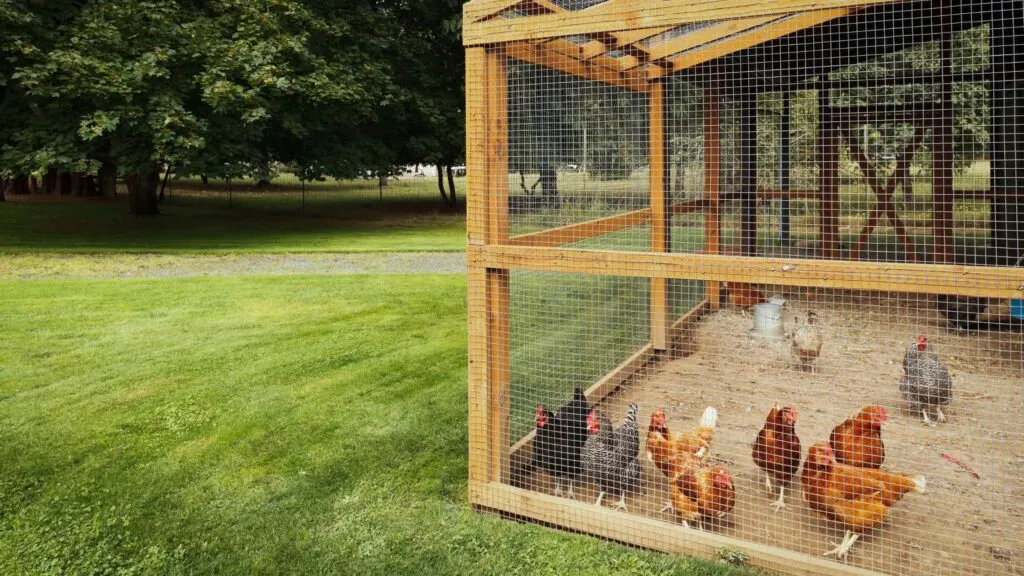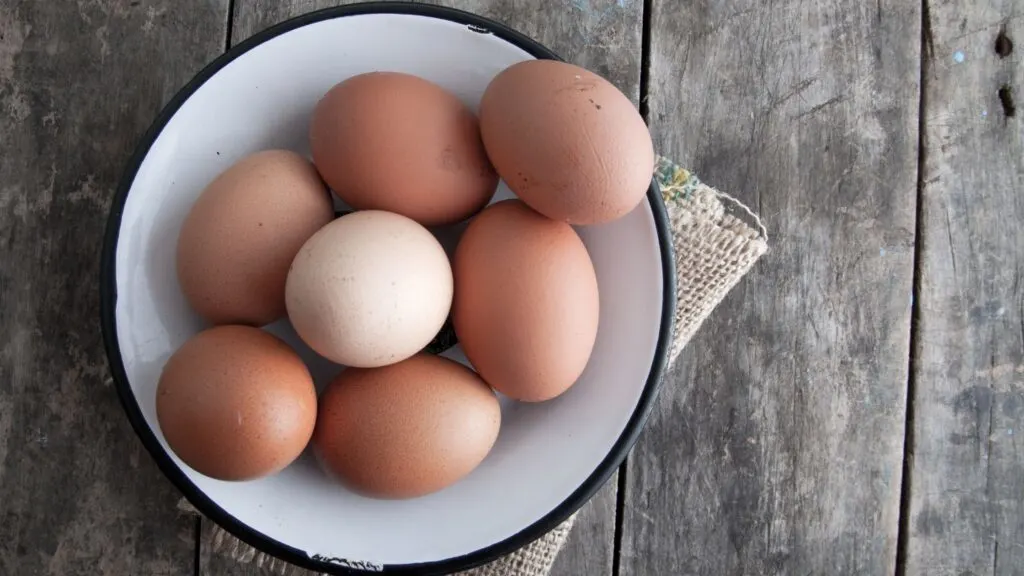A Frame chicken coops are a great idea for the backyard homesteader who doesn’t have a ton of land to work with. After free-ranging our chickens for the last eight years, I’m almost ready to keep them in a coop, and an A-frame chicken coop would work well.
However, choosing the right type of mobile chicken coop can be a bit overwhelming, especially with the many options available. One type that is becoming increasingly popular is the A-frame chicken coop.
In this blog post, we will explore the benefits of using an A-frame coop and why it might be the best option for you, plus a huge roundup of a frame chicken coops to inspire you.

Mobility
One of the most significant benefits of an A-frame chicken coop is its mobility. These coops are designed to be moved around your yard or pasture, giving your chickens access to fresh grass and various insects to snack on.
This is important because it helps keep your chickens healthy and happy and has the added benefit of reducing the parasites and pests that can build up in a stationary coop.
Also, moving your coop around means you can easily rotate your flock’s grazing area, preventing your yard from getting overgrazed and reducing the maintenance required.

Space
A-frame chicken coops are great for those with limited space or only a few chickens. These coops are typically smaller in size and can accommodate around 3-5 chickens on average. However, this doesn’t mean the coop is cramped or uncomfortable for your birds.
A-frame coops are designed to provide plenty of space for your chickens to perch, move around, and lay their eggs comfortably.
When you are building any backyard chicken coop, add in some roosting bars for your chickens in your enclosed area. They will instinctively go up to the highest spot in their coop when the sun starts setting.
Keep in mind where you will keep the feed bins and if you will have a separate feed room for storage.
Versatility
A-frame chicken coops are incredibly versatile and can be designed and constructed to meet your needs and preferences. You can build them using various materials such as wood, PVC pipes, or metal.
You can also add features such as easy access nesting boxes, perches, and doors to make the coop more functional and easy to use. Additionally, A-frame coops are suitable for urban and rural settings, making them an ideal option for any homeowner or homesteader.
With a chicken tractor, you can have your bird’s free range as well. Some examples below show that some chicken owners open the door and let the flock free range. We also do this, but our chicken coop is now inside the barn.
Security
A-frame backyard chicken coops are reasonably secure and designed to offer your chickens a safe space. They typically have chicken wire mesh walls to help prevent predators such as foxes, raccoons, and other wild animals from accessing the chickens.
We like to use the chicken wire underground when setting up a chicken run so that predators aren’t digging under the coop. We did have that happen once to ensure the ground is tight, not loose and has chicken wire underneath it.
In one of our chicken tractors, the wood is also thick at the bottom, making it harder for a raccoon to dig under.
However, it’s important to note that these coops may not be entirely predator-proof, and additional measures may be necessary to ensure your chickens’ safety, depending on where you live and the types of predators in your area.

Cost-Effective
A-frame chicken coops are incredibly cost-effective and can be built using various materials and methods. This makes them an ideal option for those on a budget but still want a quality chicken coop. Also, A-frame coops are easy to build, and many people can construct them with minimal DIY skills, saving them even more money.
You can really adjust these types of coops depending on your skill level, you’ll see from the roundup below you can keep it basic or go all out.
We keep our meat birds in a mobile chicken coop now because they are only here for 5-6 weeks. This way, they still get plenty of fresh air, have a few roosting bars, and can access grass, even though the meat birds seem to care less about grass after a few weeks and only about the feed.

Fresh Eggs
The beauty of raising backyard chickens is the fresh eggs! Once you learn how to maximize your egg production, you’ll enjoy farm-fresh eggs daily, even through the colder months.
Keep in mind how many nesting boxes you will need for your chickens. Typically, starting with six chickens, you’ll only need two nesting boxes.
Remember if you get six hens, six eggs will come every day. They add up quickly.
If eggs are your main reason for raising chickens, research the best breeds of chickens for egg production.
Easy Cleaning
Another great thing about a portable chicken coop is the cleaning. You won’t have to worry about cleaning out the run area, and only the top part where the chickens go at night.
We used a leftover piece of stainless steel for the bottom of our backyard chicken coop. This is the easiest way to slide the shavings right out of the coop.
This coop is only used for our meat birds or when we have chickens that will hatch eggs. Remember the door access for the birds and for you to easily clean the coop out.
The nesting area is another spot to ensure you can grab the eggs out easily and clean them out if needed.
The Cons of a Frame Chicken Coop
Is an A-frame coop the right choice for your chickens? While it provides excellent ventilation in the summer, colder months can be a different story. The unique design that keeps things cool can also make it chilly when the snow falls.
Speaking of snow, the steeply sloping roof of an A-frame coop can lead to a dangerous buildup. Your chickens might feel like they’re in the Arctic!
Space is another consideration. A-frames may be cute, but they don’t give you much space. If you have a large flock or plan on expanding, your chickens might not be happy in cramped quarters.
And let’s not forget about the challenges of moving a portable coop in cold climates. Wrestling with a coop in deep snow or ice is no fun, and it can be pretty amusing for your hens to watch!
The most important considerations for this type of coop are your climate and the number of chickens you want to raise. You may want to keep different coops in mind, depending on your answers.
Where we live, I’ll open the chicken coop door some days, but the snow has covered the opening. Then there are the chickens that refuse to walk out in the snow unless you shovel a path.

Is it Easy to Build? Here are the steps to build your very own movable chicken mansion:
Step 1 – Build A-frame First things first, we need to build our A-frame. This is the skeleton of our chicken tractor. Don’t worry, it’s not as complicated as it sounds. Picture a big triangle.
That’s your A-frame. Use sturdy wood and make sure your angles are correct. Remember, this will be home sweet home for your chickens, so we want it to be safe and sound.
Step 2 – Construct Enclosed Coop Area Next up, we need to construct an enclosed coop area within the A-frame. This is where your hens will sleep and lay their eggs. Don’t skimp on space here; your girls need room to stretch their wings. And don’t forget to include a door for easy egg collection!
Step 3 – Install Chicken Wire (or Hardware Cloth) Once your coop is built, it’s time to install the chicken wire (or hardware cloth if you prefer). This is what keeps your chickens in and predators out. Make sure it covers all open sides of the A-frame securely. We don’t want any crafty foxes sneaking in for a midnight snack!
Step 4 – Add Roof Now, we add the roof. This is crucial for protecting your flock from the elements. You can use corrugated metal, plastic, or even shingles. Whatever you choose, make sure it’s sturdy and weather-resistant.
Step 5 – Install Wheels (optional). Here’s where they get the “tractor” part of the chicken tractor. If you want your coop to be easily movable, consider installing wheels. Trust me, your back will thank you.
Step 6 – Add Finishing Touches Finally, add any finishing touches. This could include painting your coop, adding a perch for your hens to roost on, or installing a dust bath (more on that later).
Here’s a great YouTube video on How to Build A Frame Chicken Tractor
Here are a frame chicken coop plans.
Moving and Managing Your A-Frame Chicken Tractor
Once your chicken tractor is complete, it’s time to move in your hens and start managing your new mobile coop.
Moving your tractor Moving your chicken tractor is as simple as pushing it to a new location. Ensure you’re not moving it too far or too often – we don’t want to stress our chickens out.
Chicken tractors in the winter In the winter months, moving your chicken tractor can become a bit more challenging due to snow and ice. If the weather gets too severe, you might need to relocate your hens to a stationary coop temporarily.
Dust bathing Dust bathing is an essential behavior for chickens. It helps them keep their feathers clean and parasite-free. Be sure to provide a spot in your chicken tractor for this crucial chicken activity.
Roosting Chickens naturally want to roost at night, so providing a perch in your chicken tractor is necessary. Make sure it’s high enough off the ground and sturdy.
And there you have it, folks! Building your own A-frame chicken tractor isn’t as daunting as it sounds. You can create a simple structure for your chickens with a little bit of elbow grease and much love.
Check out these free chicken coop design ideas.
Roundup of Great Design Pictures of A Frame Simple Chicken Coop Ideas
A-frame chicken coops are an excellent option for anyone interested in keeping chickens, especially those on a budget or with limited space.
With their mobility, space efficiency, versatility, security features, and cost-effectiveness, it’s no wonder why they are becoming increasingly popular among homesteaders and chicken keepers alike.
Whether you’re just starting or are an experienced chicken keeper, an A-frame chicken coop may be your best option.
